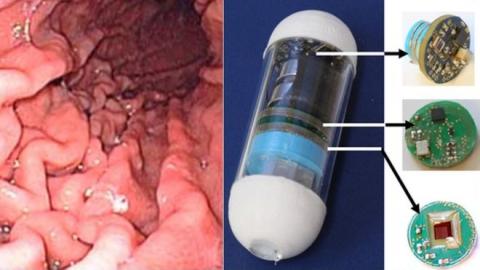Glasgow University Scientists Develop New 'Video Pill'
Published: 6 December 2016
Scientists have developed a new type of swallowable camera that could better help detect throat and gut cancers.
 Scientists have developed a new type of swallowable camera that could better help detect throat and gut cancers.
Scientists have developed a new type of swallowable camera that could better help detect throat and gut cancers.
"Video-pills" are already used, rather than endoscopes, as a less intrusive way of looking inside patients.
The spectrum of visible light they use, however, has restricted medics to conclusions based on what they can see.
Glasgow University researchers have now used fluorescent light for the first time to expand the diagnostic capabilities of the video-pill.
The pill is not yet in clinical use but developers are keen to expand the systems to new areas such as ultrasound.
Research associate, Dr Mohammed Al-Rawhani, said: "The system we've developed is small enough and power-efficient enough to image the entire human gastrointestinal tract for up to 14 hours.
"We've confirmed in the lab the ability of the system to image fluorescence 'phantoms' - mixtures of flavins and haemoglobins which mimic closely how cancers are affected by fluorescence in parts of the body like the intestines, the bowel and the oesophagus.
"The system could also be used to help track antibodies used to label cancer in the human body, creating a new way to detect cancer.
'New technique'
Dr Al-Rawhani added: "It's a valuable new technique which could help clinicians make fewer false positives and negatives in cancer diagnosis, which could lead to more effective treatment in the future."
The fluorescence imaging technique is already an established diagnostic tool in medicine but it is known to be expensive and bulky, usually confining it to laboratories.
However, the university's School of Engineering team has managed to use fluorescence imaging in a small pill form for the first time using an advanced semiconductor single-pixel imaging technique.
Project leader Prof David Cumming, the university's chair of electronic systems, said: "We've played an important role in developing the technology behind video-pill systems and this is an exciting new development which offers a valuable new resource for gastrointestinal imaging.
"There's still some way to go before it will be ready for commercial production and clinical use but we're in early talks with industry to bring a product to market.
"We're also interested in expanding the imaging capabilities of video-pill systems to new areas such as ultrasound in the near future."
The team's research has been published in the journal, Scientific Reports.
First published: 6 December 2016
<< News

